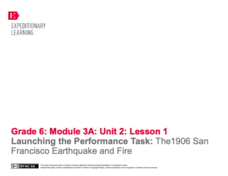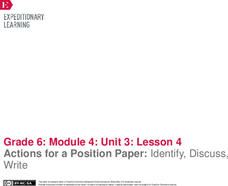Curated OER
What Do You Know? (Creating a K-W-H-L Chart)
Students complete a chart showing what they know about the Holocaust, what they want to know, how they're going to find it, and what they learned.
Curated OER
Creating a Savings Chart
Student create a savings chart given a set allowance per week. They explain how people in the local community make choices about using goods, services, and productive resources, and how they compare costs and benefits in economic...
Curated OER
Let Freedom Sing: A Patriotic Program for Grades 1 - 6
Students explore the history, meaningful background, and significance of Patriotic songs in the eight lessons of this unit. Each of the different grade levels experience a different amount of lessons all culminating in a Patriotic Program.
Curated OER
Atlatl Lessons for Grade 4
Fourth graders explore the weapons of the Aboriginal people. In this fourth grade math lesson, 4th graders create charts, tables, or diagrams to represent patterns and relations. Students investigate which dart length has the best...
Curated OER
Seasons Chart
In this science worksheet, students investigate the seasons of the year by completing a circular chart which has been divided into 4 quadrants. Students write the names of the months which belong to each season, illustrate and label the...
Curated OER
Percent-Decimal-Fraction Chart Worksheet
In this percent-decimal-fraction worksheet, students complete a table where one component is given and they find the other two missing equivalent figures, a percent, a decimal or a fraction. The problems on this worksheet are at an 8th...
Curated OER
Word Chop: Grade Three Vocabulary List Two
In this word part worksheet, students study the word parts that have been fragmented. Students find the pieces that fit together from the chart and write them on the answer lines.
Curated OER
Five W's Chart
In this five W's chart worksheet, students fill in a graphic organizer with facts about the five W's: What, Who, Why, When and Where. Chart is for use with interactive white boards.
Curated OER
Ten Frame Chart
In this math worksheet, students analyze a ten frame chart. Students may use the two by five chart for a variety of math activities.
Curated OER
Hundreds Chart: Missing Numbers
In this hundreds chart worksheet, students fill in missing numbers to complete the chart. A web site reference for additional activities is given.
EngageNY
Close Reading: Paragraphs 1–5 of “Water Is Life”
Be more specific. Scholars take a look at domain-specific vocabulary by discussing an anchor chart. They then look at vocabulary words recorded from paragraphs one through five in Water of Life. After analyzing the vocabulary used in the...
EngageNY
Reading for Gist and Analyzing Point of View: Moon Shadow
Character analysis isn't always earth-shattering. Using a graphic organizer, pupils analyze Moon Shadow's point of view following the earthquake in Laurence Yep's Dragonwings. Also, scholars co-create an anchor chart showing the...
EngageNY
Close Reading of Nasreen's Secret School: How Do People Access Books in Afghanistan?
Third graders continue to practice the close reading skills of capturing the gist and reading again for important details in the sixth instructional activity in a larger unit. This is a great beginning-of-the-year unit for establishing...
EngageNY
Launching the Performance Task: The1906 San Francisco Earthquake and Fire
Picture that! Pupils view photographs of the aftermath of the 1906 San Francisco earthquake and fire, discussing what they know and wonder about each image. Then, scholars watch a short video about the historic event and complete a KWL...
EngageNY
Actions for a Position Paper: Identify, Discuss, Write
Anchors aweigh, it's time to write! After viewing an anchor chart detailing the parts of a position paper, pupils share their plans for their essays with a partner. Next, they write the rough draft of their body paragraphs.
EngageNY
Evaluating Sources, Continued: The ONLINE EDUCA Debate 2009 (Part 2 of 10)
Watching videos and playing online games can be educational, but too much screen time has its drawbacks. Pupils watch a video about the topic and write down the claim, reasons, and evidence in support of reduced screen time for children....
EngageNY
Characters’ Decisions: The Flow of Consequences in Midsummer
Class members meet in their drama circles and share their thoughts on why it might be necessary for the audience to know something the characters don't. They read Act 3 Scene 2 of A Midsummer Night's Dream and complete consequence flow...
Student Handouts
Blank Pyramid Charts
From feudal societies to European monarchies, a blank pyramid template can support your learners in understanding social hierarchies and distinctions between classes.
EngageNY
Setting Purpose for Research: What are Fair Working Conditions?
Life may not be fair but working conditions should be. Scholars research working conditions at Wegmans by studying the company website. They complete a working conditions anchor chart and discuss their findings in a think-pair-share...
EngageNY
How to Write Like a Scientist in the Field: Introduction to the Elements of Field Journals
It's time to start journaling. Scholars look at examples of science field journals. They work in pairs to examine and complete a note catcher about a field journal. They then add to an anchor chart by discussing the different features...
EngageNY
Reading for Gist: “Middle Ages” Excerpt 1
Dig deep. Scholars dig deep for meaning while reading Middle Ages Excerpt 1. They begin by finding unfamiliar words and adding them to a word catcher. Pupils then take a close look at adversity in the text and complete an anchor chart.
EngageNY
Finding the Gist of the Immediate Aftermath: Excerpt of “Comprehending the Calamity”
Brace for the aftershocks! Scholars read an excerpt from a primary source document about the immediate aftermath of the 1906 San Francisco fire and earthquake. Next, pupils complete an anchor chart, analyzing how the author introduces,...
EngageNY
Presenting a Research-Based Claim: Visual Aid and Peer Critique
Back to the drawing board. Scholars work on the visual to complement their claim presentations using the Criteria for the Cascading Consequences Chart Visual as a guide. They then practice their presentations with partners.
EngageNY
Building Background Knowledge: Competing Views Regarding Mining on Inuit Lands
Scholars build background knowledge about mining on Inuit lands. Working in small groups, they sort information about the Inuit onto a point of view chart to determine if mining is beneficial to Inuit communities.

























